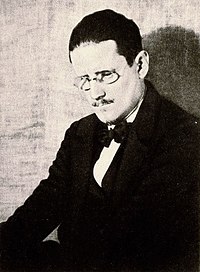
James Joyce - Sep 1922 Shadowland.
(Image by Wikipedia (commons.wikimedia.org), Author: Man Ray) Details Source DMCA
Duluth, Minnesota (OpEdNews) March 3, 2022: Early in the twentieth century, around the time of World War I (1914-1918), the movement known as literary modernism emerged in the Western world. In the English language, two iconic exemplars of literary modernism are the Irish novelist James Joyce (1882-1941) and the English novelist Virginia Woolf (1882-1941).
Around the same time, but in a different intellectual domain, the Austrian Jewish neurologist and psychoanalyst and psychological theorist Sigmund Freud (1856-1939) and the Swiss Protestant psychiatrist and analytic psychotherapist and psychological theorist Carl G. Jung (1875-1961) emerged to spearhead the inward turn in psychotherapy. However, Jung claimed that Freud and his followers were concerned with ego-consciousness, whereas Jung and his followers were concerned with the deeper realm of the human psyche involving the archetypes.
Now, Virginia Woolf and her husband Leonard Woolf (1880-1969) owned and operated Hogarth Press. Their friends James Strachey (1887-1967) and his wife Alix Strachey (1892-1973) translated Freud's works into English, and Hogarth Press published them. To this day, Hogarth Press holds the copyright of the Standard Edition of the Complete Psychological Works of Sigmund Freud.
Now, James Joyce and his wife Nora Barnacle Joyce (1884-1951) had a son and a daughter: Giorgio Joyce (1905-1976) and Lucia Joyce (1907-1982). Lucia Joyce was diagnosed with schizophrenia in the mid-1930s and was treated by C. G. Jung.
In any event, both James Joyce and Virginia Woolf published beautifully written novels about their childhood experiences: A Portrait of the Artist as a Young Man (1916) and To the Lighthouse (1927), respectively. Perhaps we could think of each of these classic novels as exemplifying the Freudian spirit of examining one's childhood experiences.
However, if we do that, then perhaps we could think of James Joyce's famous experimental novel Ulysses (1922) as exploring both the Freudian spirit of examining one's own personal history and the Jungian spirit concerned with the deeper realm of the psyche involving the archetypes.
For the purposes of exploring the archetypal realm of the psyche, James Joyce uses the Homeric epic the Odyssey as the literary exemplar for structuring the eighteen chapters of the odyssey of the three main characters - (1) the mythological Dedalus, Stephen Dedalus; (2) the mythological Wandering Jew, Leopold Bloom; and (3) the archetypal earth goddess, Molly Bloom -- on one day, June 16, 1904 (the year in which James Joyce turned 26) - now known as Bloomsday.
The Greek mythological figure of Daedalus is associated with the labyrinth and Ariadne's thread and the flight of Icarus and the Shield of Achilles. See the Wikipedia entry on Daedalus for further information.
Like the character named Stephen Dedalus in A Portrait of the Artist as a Young Man (1916), the character named Stephen Dedalus in Ulysses (1922) is based on James Joyce himself, who was educated by Jesuits in Ireland and introduced by them to Aristotelian-Thomistic philosophy and theology, which he subsequently studied further on his own. Echoes of Aristotelian-Thomistic philosophy and theology occur in Stephen Dedalus' inner monologues.
For a relevant discussion of Aristotelian-Thomistic philosophy and theology, see the American Jesuit literary scholar William T. Noon's book Joyce and Aquinas (Yale University Press, 1957). The American Jesuit literary scholar Walter J. Ong perceptively reviews Noon's book in the journal The New Scholasticism, 31(4) (October 1957): pp. 553-555. If you have access to Ong's review, it repays careful reading. In it, among other things, he refers to James Joyce as "an ear-man rather than an eye-man" (p. 555).
Now, just as Stephen Dedalus is based, in part, on James Joyce, so too Molly Bloom is based, in part, on Nora Barnacle.
For a biography of Nora Barnacle Joyce, see Brenda Maddox's book Nora: The Real Life of Molly Bloom (Boston: Houghton Mifflin, 1988).
In addition to literary allusions to the Odyssey, other literary allusions abound in the novel, including allusions to the Hebrew Bible and Shakespeare's Hamlet. If I had to sum up the novel's style in one word, that word would be allusive.
For an informed and judicious study of the oral style of the Homeric epics the Iliad and the Odyssey, see John Miles Foley's book Homer's Traditional Art (Pennsylvania State University Press, 1999).
(Note: You can view every article as one long page if you sign up as an Advocate Member, or higher).




